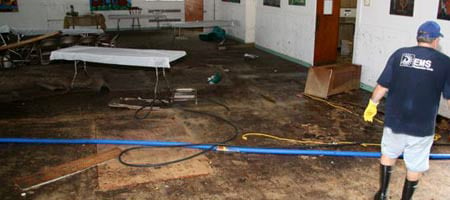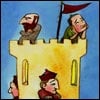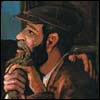A massive storm left the interior of a Long Island synagogue in ruins and its leadership wondering how to fund the necessary rebuilding.
According to Rabbi Anchele Perl, co-director of Chabad-Lubavitch of Mineola and rabbi of Beth Shalom Chabad synagogue, the July 18 severe weather system – which stranded motorists, knocked out power across the New York area and spawned a freak tornado in the midst of driving rain – caused a flash flood that destroyed much of the synagogue's ground floor. Perl narrowly escaped the rising water; the congregation's Torah scroll was ruined.
"It was a tremendous loss," said Perl. "However, we will be able to rebuild, and not only will we rebuild, but we will rebuild an even nicer synagogue."
That kind of optimism may be characteristic for Perl, but by all estimates the task of raising at least half a million dollars to fix the damage will likely prove daunting.
When Perl arrived to the synagogue that Wednesday morning, he said, he had no idea that the storm, already at full steam, could have gotten so bad. As he opened the door, he noticed rain water seeping into the ground floor; he immediately began mopping up and placed the congregation's books, boxes and files onto tables so they wouldn't get wet.
But the rabbi quickly realized that nothing he was doing was preventing more and more water from entering the synagogue, so he went upstairs to call emergency services and the insurance company. When he went to the staircase to check on the damage just 20 minutes later, the water had risen five feet.
When he was finally allowed to go downstairs – fear of live electrical wires producing a short led emergency personnel to direct the rabbi to remain on the second floor – did he see the extent of the damage: The flood had overturned the synagogue's ark, holding its precious Torah, and submerged thousands of holy books and files. Perl's study was left in ruins.
He later told clean-up volunteers, many of whom had just walked past and offered to help, that he carried the damaged scroll upstairs with tears in his eyes. He did not know, he said, if it can be repaired.
A Time of Opportunity
Beth Shalom's tale of loss in many ways mirrored stories all over Long Island. Quoting municipal officials, USA Today reported that four house fires, likely a result of lightning strikes, were reported in the wake of the storm. At the Nassau University Medical Center in East Meadow, 10 inches of water filled the basement and parts of the ground floor, affecting operations in the emergency room.
The loss of the synagogue's Torah, though, represented more than just a physical and emotional setback.
"On Friday, I saw a picture of Rabbi Perl [in the newspaper] with his pants rolled up, holding the Torah and walking in knee high water," said community member David Lerman. "I felt I had to do something for the rabbi who has done so much for me. I called a friend and we hopped into the car and we headed out to the synagogue."
In spite of the tragedy, said Lerman, Perl managed to look on the bright side.
"We were clearing out the room and when we came to the hallway, Rabbi Perl was dancing," he said. "He told me that when the first Holy Temple in Jerusalem was destroyed, a much nicer one was built in its place."
Perl explained his optimism by telling of something that happened shortly before Lerman arrived: When the rabbi entered the synagogue's library – many of its books, damaged beyond repair, are headed for burial in accordance with Jewish law – he noticed two books that had miraculously escaped the destruction, a volume on Jewish mourning practices and a compendium of teachings of the Lubavitcher Rebbe, Rabbi Menachem Mendel Schneerson, of righteous memory.
He immediately realized that even though mourning is a heart-rendering and challenging time, it is not proper to be depressed and give up. For him, the storm's aftermath was a time for acceleration. He remembered then, he said, that in the midst of mourning his recently departed wife, the Rebbetzin Chaya Mushka, the Rebbe called for more and more institutions to be built in her memory.
Today, the synagogue's main floor resembles a shell of its former shelf. It's wood floors and paneling have been removed to control the spread of mold.
That did not stop the congregation, however, from holding Shabbat services just three days later. Community members even enjoyed a traditional kiddush, complete with a simmering stew known as cholent. The rabbi said he consoled his congregants with the promise of more classes and activities befitting a bigger and better synagogue.
Noting that the flood came in the midst of the mourning period over the Temple's destruction, Lerner said: "In the days when we mourn the destruction, our synagogue was destroyed. But we will build a much more beautiful and nicer synagogue."








Join the Discussion